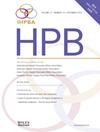接受第二次和第三次结肠直肠癌肝转移切除的患者复发风险并未降低。
IF 2.7
3区 医学
Q2 GASTROENTEROLOGY & HEPATOLOGY
引用次数: 0
摘要
背景:重复肝切除术是复发性结直肠肝转移(CLM)患者的一种成熟的治疗选择。然而,没有评估第二次和第三次CLM切除术后复发的风险。方法:从一个前瞻性维护的数据库中获取2005年至2018年间接受第一次、第二次和第三次CLM切除术的患者数据。结果:在695例患者中,分别有486,159和50例进行了第一次,第二次和第三次CLM切除术。第一次、第二次和第三次CLM切除术患者的复发风险变化,以及第一次和第二次CLM切除术患者在一定时间内无复发的累积复发曲线相对相似。第一次CLM切除术后复发时间≤12个月(HR 2.09, 95% CI 1.35 ~ 3.23, P = 0.001)和CLM数量(HR 1.07, 95% CI 1.02 ~ 1.12, P = 0.003)是第二次CLM切除术患者复发的重要危险因素。结论:第二次和第三次CLM切除术患者的复发风险并不低于第一次CLM切除术患者。第二次和第三次CLM切除术后的监测策略应与第一次CLM切除术后的监测策略相似。本文章由计算机程序翻译,如有差异,请以英文原文为准。
Risk of recurrence does not decrease in patients undergoing the second and third resection of colorectal liver metastases
Background
Repeat liver resection is a well-established treatment option for patients with recurrent colorectal liver metastases (CLM). However, the risk of recurrence following the second and third CLM resections was not assessed.
Methods
Data of patients undergoing first, second, and third CLM resection between 2005 and 2018 were obtained from a prospectively maintained database.
Results
Of the 695 patients, 486, 159, and 50 underwent first, second, and third CLM resections, respectively. The changing risks of recurrence in patients undergoing first, second, and third CLM resection, and the cumulative recurrence curve after a given interval without recurrence in patients undergoing first and second CLM resection were relatively similar. Time to recurrence after the first CLM resection ≤12 months (HR 2.09, 95% CI 1.35–3.23, P = 0.001) and number of CLM (HR 1.07, 95% CI 1.02–1.12, P = 0.003) were significant risk factors for recurrence in patients undergoing second CLM resection.
Conclusion
Patients undergoing second and third CLM resection did not have a lower risk of recurrence than those undergoing first CLM resection. The surveillance strategy after the second and third CLM resections should be similar to that after the first CLM resection.
求助全文
通过发布文献求助,成功后即可免费获取论文全文。
去求助
来源期刊

Hpb
GASTROENTEROLOGY & HEPATOLOGY-SURGERY
CiteScore
5.60
自引率
3.40%
发文量
244
审稿时长
57 days
期刊介绍:
HPB is an international forum for clinical, scientific and educational communication.
Twelve issues a year bring the reader leading articles, expert reviews, original articles, images, editorials, and reader correspondence encompassing all aspects of benign and malignant hepatobiliary disease and its management. HPB features relevant aspects of clinical and translational research and practice.
Specific areas of interest include HPB diseases encountered globally by clinical practitioners in this specialist field of gastrointestinal surgery. The journal addresses the challenges faced in the management of cancer involving the liver, biliary system and pancreas. While surgical oncology represents a large part of HPB practice, submission of manuscripts relating to liver and pancreas transplantation, the treatment of benign conditions such as acute and chronic pancreatitis, and those relating to hepatobiliary infection and inflammation are also welcomed. There will be a focus on developing a multidisciplinary approach to diagnosis and treatment with endoscopic and laparoscopic approaches, radiological interventions and surgical techniques being strongly represented. HPB welcomes submission of manuscripts in all these areas and in scientific focused research that has clear clinical relevance to HPB surgical practice.
HPB aims to help its readers - surgeons, physicians, radiologists and basic scientists - to develop their knowledge and practice. HPB will be of interest to specialists involved in the management of hepatobiliary and pancreatic disease however will also inform those working in related fields.
Abstracted and Indexed in:
MEDLINE®
EMBASE
PubMed
Science Citation Index Expanded
Academic Search (EBSCO)
HPB is owned by the International Hepato-Pancreato-Biliary Association (IHPBA) and is also the official Journal of the American Hepato-Pancreato-Biliary Association (AHPBA), the Asian-Pacific Hepato Pancreatic Biliary Association (A-PHPBA) and the European-African Hepato-Pancreatic Biliary Association (E-AHPBA).
 求助内容:
求助内容: 应助结果提醒方式:
应助结果提醒方式:


